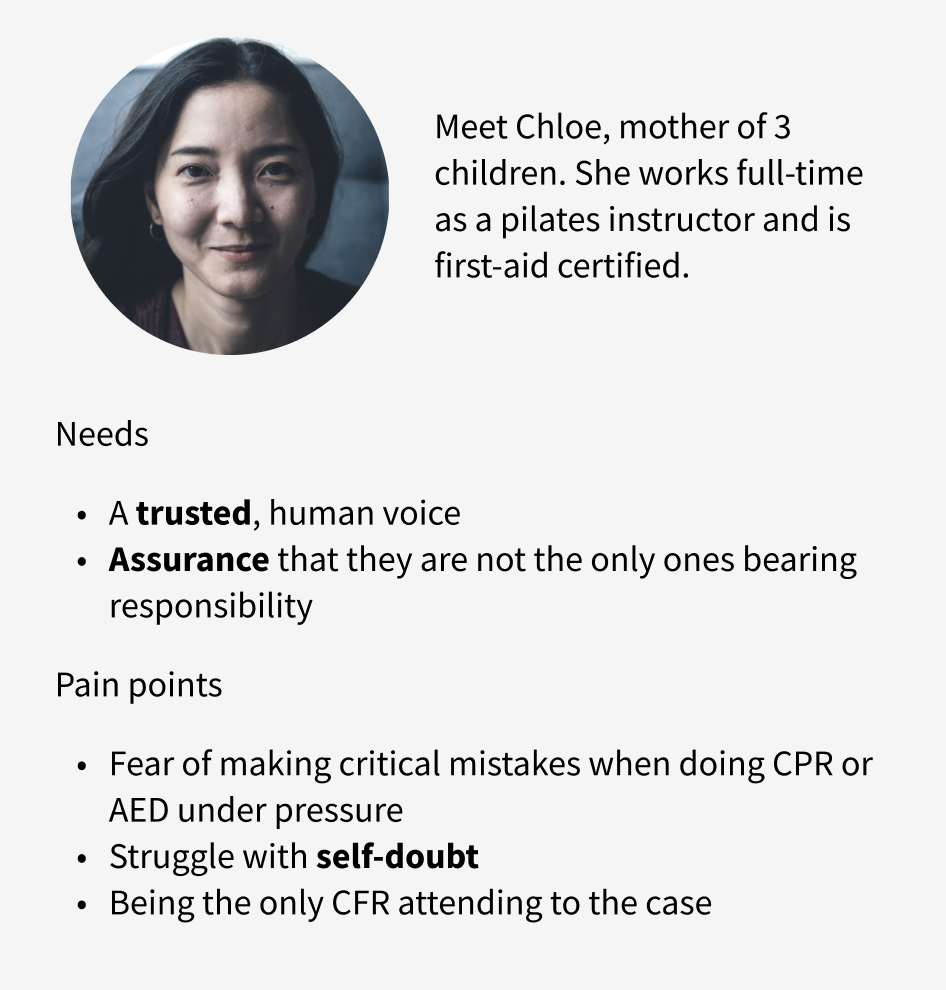From Research to Rescue: Empowering Singaporeans to Respond to Emergencies
Client: Singapore Civil Defence Force (SCDF)
Role: Lead Researcher → Content Designer & Usability Tester
Team: 3 Designers, Design Lead, Research Lead, Project Lead
Duration: 2 weeks (tender), 4 months (project)
The Challenge
When someone collapses from cardiac arrest, every minute without CPR reduces their survival rate by 10%. The SCDF's MyResponder app was created to alert trained volunteers nearby—but too often, even certified responders hesitated when the notification came through.
For MyResponder 2.0, we needed to solve two problems:
Between emergencies ("peace time"), how might we better prepare people?
During emergencies, how might we help them overcome the freeze response?
As the project's lead researcher, then later as content designer and usability tester, I worked to bridge that gap between knowledge and action.
Understanding the Psychology of Hesitation
I led six in-depth interviews with a mix of participants: from those who are currently or previously first-aid certified, to those who have never certified.
Our initial interviews uncovered a critical insight: knowledge alone does not guarantee confidence, and confidence is largely impacted by experience. Therefore, a first-aid certification doesn't automatically translate to increased confidence when responding in an emergency.
A 54-year-old participant with first-aid training stated:
To refine our insights, we developed a knowledge-experience matrix, with an objective statement placed in each quadrant to inform our design strategy. The y-axis indicates knowledge level (from untrained to certified), while the x-axis indicates experience level (from never responded to multiple emergencies).
Knowledgeable but no experience → Hesitant due to psychological barriers, such as self-doubt and a fear of making critical mistakes.
Low knowledge, no experience → Unaware of their role as responders.
Experienced but lacking formal training → Rare but needs guidance.
The most telling quadrant? Knowledgeable but inexperienced—people who theoretically know what to do, but might struggle to act confidently in a real crisis.
Take Chloe, our key persona. She could demonstrate perfect CPR on a dummy, but her real barriers were psychological:
This reframed our challenge. The app needed to do more than teach—it had to build emotional readiness.
Crafting a Voice That Steadies Hands
Medical apps typically fall into two extremes: sterile and impersonal (such as Drugs@FDA) or overly playful (such as Clu’). We carved out a middle ground—the “Reassuring Expert”—blending the authority of a paramedic with the empathy of a trusted coach.
Inspired by apps like Headspace, we designed content to adapt dynamically: educational yet engaging during peace time, direct yet supportive during emergencies. We baked the sweet spot tone into every interaction:
Peace Time: Building Confidence Through Guided Learning
In the Learn tab, we transformed skill-building into a collaborative journey. Gamification elements—badges, progress bars, and prompts like "Let’s try” and “Let’s go”—made mastering CPR feel approachable, not daunting. But unlike trivialised "games," our design celebrated milestones with purpose:
Progress trackers - "Keep it up, you’re halfway there!"
Badges tied to real-world impact e.g., "Fire-fighting hero" for completing simulations
Emergency Time: Clarity Under Pressure
For responders like Chloe—who knew the steps but feared the pressure—we designed every interaction to reduce cognitive load and build confidence:
Step-by-step guidance:
Clear, visual instructions: Pairing concise text with intuitive imagery to accelerate comprehension under stress.
Minimalist interface: Only critical actions visible (e.g., "995", "Guides”), with secondary options like Cancel response tucked into a menu—preserving focus while retaining user control.
Psychological safety nets:
Red ‘995’ button: Leveraging SCDF’s emergency colour coding for instant recognition, reinforcing that help is one tap away.
Post-case care: A well-being check-in ("How are you feeling after the incident?") with options to access support resources, validating emotional responses.
Empathetic language:
Relational messaging: Using "You" and "We" to simulate a human connection (e.g., "You’re not alone—we’ll guide you through this").
Affirmation post-response: "Thank you for stepping up. Your actions made a difference."
[Emergency flow screen recording: Highlight the transition from alert → action steps → post-case support.]
This wasn’t just UX writing; it was designing for emotional resilience.
What Well-Being Checks Revealed About Motivation
Usability testing yielded surprises. When we asked users to rank features, the well-being check—a simple prompt asking "How are you feeling today?"—outperformed flashier elements like gamification. One participant said, "Seeing that someone at SCDF cares if responders are okay... it makes me want to stay active in the community."
Conversely, features we assumed would drive engagement missed the mark:
87.5% ignored generic stats like "total responses"—they only cared about their recent activity
Badges for responding to cases felt inappropriate ("This isn't a game"), but badges for completing courses were welcome
The game interface, intended to make learning fun, was dismissed as frivolous by our core demographic
[show UT changes in powerpoint animated slide]
These insights led to ruthless prioritization:
Replaced the dashboard's "Alerts Within 500m" with personalized case history
Moved badges exclusively to the learning section
Scaled back gamification in favor of community stories—real accounts from other responders that normalized fear and built collective identity
The Ripple Effects
Six months post-launch, the data showed subtle but meaningful shifts:
42% increase in users completing the "Readiness Checklist" (now positioned as self-care rather than homework)
28% longer session times on training modules after introducing scenario-based learning
Most tellingly, several users referenced the well-being check in app store reviews: "It's like having SCDF check in on you as a person, not just a responder."
The biggest lesson? Preparedness isn't just skills—it's state of mind. By designing for the emotional journey as rigorously as the functional one, we helped close the gap between knowing what to do and actually doing it.




